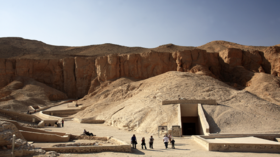Archaeologists have discovered an unfinished 3,800-year-old ancient Egyptian tomb with a small temple perfectly aligned with the sunrise at the winter solstice.
Archaeologists say it may be the oldest known tomb in Egypt that coincides with the winter solstice.
The necropolis was built near modern Aswan during Egypt’s Twelfth Dynasty as part of the period when Egypt flourished and is sometimes referred to as the “Middle Kingdom”.
It was located in the Qubbet al-Hawa necropolis, researchers wrote in a study published in July in the Mediterranean Journal of Archeology and Archeometry. In ancient times, grave robbers robbed most of the artifacts placed in the cemetery, including the mummies of monarchs. Although the name of the governor who first built the tomb is unknown, according to an inscription found in the tomb and historical records, the name of another ruler buried here is Hakib the Third.
Both monarchs ruled the nearby town of Elephantine at different times, and the team said in a statement that the burial chapel actually included an area intended to house a statue of the monarch who built the tomb. .
Study co-author Alejandro Jimenez Serrano, an Egyptologist and archaeologist at the University of Jaen in Spain, told Live Science in an email that the tomb and statue were never finished. Serrano, the leader of the excavations carried out by the teams at the excavation site, said that the team “found an unfinished statue outside the tomb that should have been finished and placed on the altar”, adding that it was not clear why the tomb is here. left missing.
The entrance to the church is built in such a way that during the winter solstice, which occurs on December 21 or December 22 every year, the sun’s rays can enter and illuminate the church. The statue and church are lit up at sunrise on the winter solstice, the day with the shortest daylight. It may be the oldest known tomb in Egypt to be aligned with the winter solstice, researchers said.
The winter solstice had an important meaning to the ancient Egyptians, the researchers said. It marks the beginning of the daily victory of light over darkness, and the light reaches its peak at the summer solstice, the longest day on Earth.
Moreover, the solstice was seen as a moment of renewal. “The lengthening of the days after the winter solstice is interpreted as rebirth. This concept was transferred to the material world, specifically embodied in the statue representing the deceased monarch,” said Jimenez-Serrano.
The tomb was first discovered by Egyptologist Sir Ernest Alfred Thompson Wallis Budge in 1885, but was not excavated until a team from the University of Jaén discovered it between 2008 and 2018. After the excavation, Egyptologists studied the geometry of the tomb, looking for any astronomical alignment.
The team used data from the architecture and virtual modeling of the tomb to see how the light in the temple changes throughout the year.
Jimenez-Serrano said the team checked other burials in the cemetery to see if there were other burials dedicated to the winter sunrise.
Source: Live Science
Source: Arabic RT
